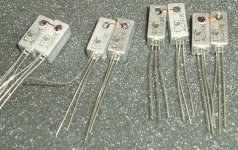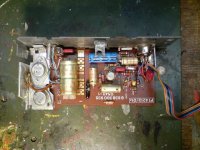I realised the other day that while I know many of the milestone points in amplifer design (Loftin-White, Williamsone, JLH etc) I have no idea of the history of the classic complementary AB transistor amplifier (as typified by the 741 op-amp)
a) first proposed complementary bipolar AB (or class A)
b) first successfully implemented it as an audio power amp
c) first used the venerable 2N3055/2N2955 pair in a product
Was it NatSemi or Philips? Or someone in Japan? Even "The Art" just assumes it is too obvious to bother attributing the design to someone.
a) first proposed complementary bipolar AB (or class A)
b) first successfully implemented it as an audio power amp
c) first used the venerable 2N3055/2N2955 pair in a product
Was it NatSemi or Philips? Or someone in Japan? Even "The Art" just assumes it is too obvious to bother attributing the design to someone.
The first quality amplifier that was complimentary output was the Radford Sca 30 designed as mentioned by Arthur Bailey It also featured a twin thyristor regulated supply that works well Also it features a large non polarised output capacitor !! I have one of these amplifiers in my collection That I have restored but it still needs a few pushbutton knobs
regards Trev
regards Trev
The first complementary silicon output power transistors were made by Motorola in 1966. I was working in industry, when they were first announced. These were the 2N3716 and the 2N3792. The pnp device cost about $13 each at the time, and that was a day's pay. For comparison, you could buy a matched pair of Genelex KT88 output tubes for about $13 at the time. The 2N3055 did not get a complement until several years, later. We were all waiting for the complementary output pair, hoping for a new age in solid state power amp design.
Last edited:
Is there any thing as a true complimentary pair ? I have read articles where it is stated that matching is only ever nominal as they have diifferant properties re speed junction area and capacitance etc.
I have also read that some designs such as Naim etc still prefer the quasi output stage as the output devices can be exact matches
Allthough in the case of a quas the top transistor is operating an a emmitter follower and the bottom as a common emmitter wity its load in the collector
Myself I am yet to work it out!
Regards Trevor
I have also read that some designs such as Naim etc still prefer the quasi output stage as the output devices can be exact matches
Allthough in the case of a quas the top transistor is operating an a emmitter follower and the bottom as a common emmitter wity its load in the collector
Myself I am yet to work it out!
Regards Trevor
The pnp device cost about $13 each at the time, and that was a day's pay.
Flipping burgers back then, John? My dad (a tradesman) was earning $9-10/hour in 1966. It wasn't 1936.
..Todd
I think you was refering to the first high power silicon bipolar transistor. AFAIK the gemanium types AD161/AD162 are still older.The first complementary output power transistors were made by Motorola in 1966. I was working in industry, when they were first announced. These were the 2N3716 and the 2N3792.
If I were a technician, I might have made $3.00/hr at the time. If you want to say 1/2 days pay, then do it, but I made $7500/ year professionally employed at Friden in 1966, and I considered myself relatively well off, compared to most. I had previously been making $2.00/hr working as a part time repair tech at Berkeley Custom Electronics, while finishing college, in early 1966. The dollar at the time was worth 4/1 to the Swiss Frank, German mark, etc. And in 1965, my sister and I got a student discount bed and breakfast in Edinborugh, Scotland for 1 lb/night. If your dad made $10/hr, he made more than a seasoned electronic engineer.
Allthough in the case of a quas the top transistor is operating an a emmitter follower and the bottom as a common emmitter wity its load in the collector
Myself I am yet to work it out!
Regards Trevor
If you apply a Baxandall diode across the lower driver emitter then the two halves become more closely matched.
If you apply a Baxandall diode across the lower driver emitter then the two halves become more closely matched.
If you also add a capacitor of about 0.1 uf across that its even closer linsley hood 75 watt
regards Trevor
If your dad made $10/hr, he made more than a seasoned electronic engineer.
It certainly sounds like it's true in your case.
..Todd
In the United States at the time, engineering was a high status, relatively high pay job. However, the building trades often had even higher wage rates than engineers, especially in the early professional (journeyman) years of being in the trades. As the years went by, and the engineers gained further experience, they would usually be paid more and more, as they assumed supervisory and even management levels, that would exceed what most journeyman level trades people would get in pay. The 'downside' of the trades is the work effort, which is usually considerable, and burn-out as the individual gets older, especially due to physical challenge. My present business partner became an electrician, and my former high school friend became a bricklayer in the early 1960's. They dropped out by their mid 30's to do other occupations. Engineers, if they do not allow themselves to go obsolete, keep growing, usually into management, where the big bucks are gotten.
Last edited:
I think you was refering to the first high power silicon bipolar transistor. AFAIK the gemanium types AD161/AD162 are still older.
I used AD161/162 at Philips in 1964. But they were medium power by today's standard.
The first high-power transistor in 1965 we got was the OC26 or 29 in a TO3 case. Don't remember if it was N or P. Must have been P Germanium.
jd
I realised the other day that while I know many of the milestone points in amplifer design (Loftin-White, Williamsone, JLH etc) I have no idea of the history of the classic complementary AB transistor amplifier (as typified by the 741 op-amp)
a) first proposed complementary bipolar AB (or class A)
b) first successfully implemented it as an audio power amp
c) first used the venerable 2N3055/2N2955 pair in a product
Was it NatSemi or Philips? Or someone in Japan? Even "The Art" just assumes it is too obvious to bother attributing the design to someone.
Very good questions and not easy to determine by searching about google.
I think the first true complementary silicon transistor pairs in Europe (to realize OTL Class AB stages) was germanium transistors like
- AD161/162 often to find in amp sections (10W - 15W) of UKW-FM Stereo receivers from German brands arround 1966 until 1973 like this:
¸ùµÂ¾ÍÊǸùµÂ¡£¾¡¹ÜÂúÉíÓ¡¿ÌÂúËêÔ²×É£ÀÛÀÛ£¬ÈÔÏÔËýÄÇï*ï*Ìú¹Ç£¡
¸ùµÂ¾ÍÊǸùµÂ£¬¾¡¹ÜËêÔ²×É£É˺ÛÀÛÀÛ£¡ - ¹ã²¥·¢ÉÕÍø - www.5bcl.com
also to find in various Blaupunkt car audio receivers from the same aera
Frankfurt 7.630.640 Radio Blaupunkt (Ideal
and still available:
Magnatec | Semiconductors | Discretes | General Purpose Transistor | Germanium Transistors |AD161-2
- AC187K/AC188K mostly to find in medium pocket radios like "Loewe Opta" Lord - see attachement and
http://www.yellab.com/auctions/AC187K-AC188K.jpg
for output power 4 watts max.
- AC127/128 - same than AC187K/188K, but without screw-block for heatsink mounting - therefore only 1W max
Until this day I haven't success to find the orig. datasheets from brands like Valvo (now NXP/Philips Components), Telefunken (now Vishay) and Siemens. I am highly interested to such datasheets.
Pocket radios and amps/receivers for low/medium output power from Japanese brands haven't true-complementary output stages in their amp sections in this aera - as I know. Instead of this there are still driver transformers and output transformers in use, even by very small pocket radios like formerly German's topologies used AD149, AD155 or OC-Series like OC26/OC36.
Here an overview about such transistors:
Wumpus. Transistors
But what types of transistors the US brands for their amplifier uses in this time? As I know, long time only quasi complementary and totem pole topologies was used.
Because the 2N3055 was released from RCA already arround 1962 I have start this thread to get more informations - unfortunately I haven't success to find amplifier models and application notes before 1970:
http://www.diyaudio.com/forums/soli...-models-quasi-complementary-power-output.html
Because I hate the so called "true complementary" PP buffer stages (causes it's only theoretical symmetric behavior) I start also this overviews:
http://www.diyaudio.com/forums/soli...better-audio-non-complements-audio-power.html
http://www.diyaudio.com/forums/soli...e-ended-related-solid-state-output-stage.html
Attachments
Last edited:
I used AD161/162 at Philips in 1964. But they were medium power by today's standard.
jd
Yes, but very good specs..
The AD161/162 pair sounded truly hifi..
- Status
- This old topic is closed. If you want to reopen this topic, contact a moderator using the "Report Post" button.
- Home
- Amplifiers
- Solid State
- What was the first Complementary AB bipolar amplifiers?


